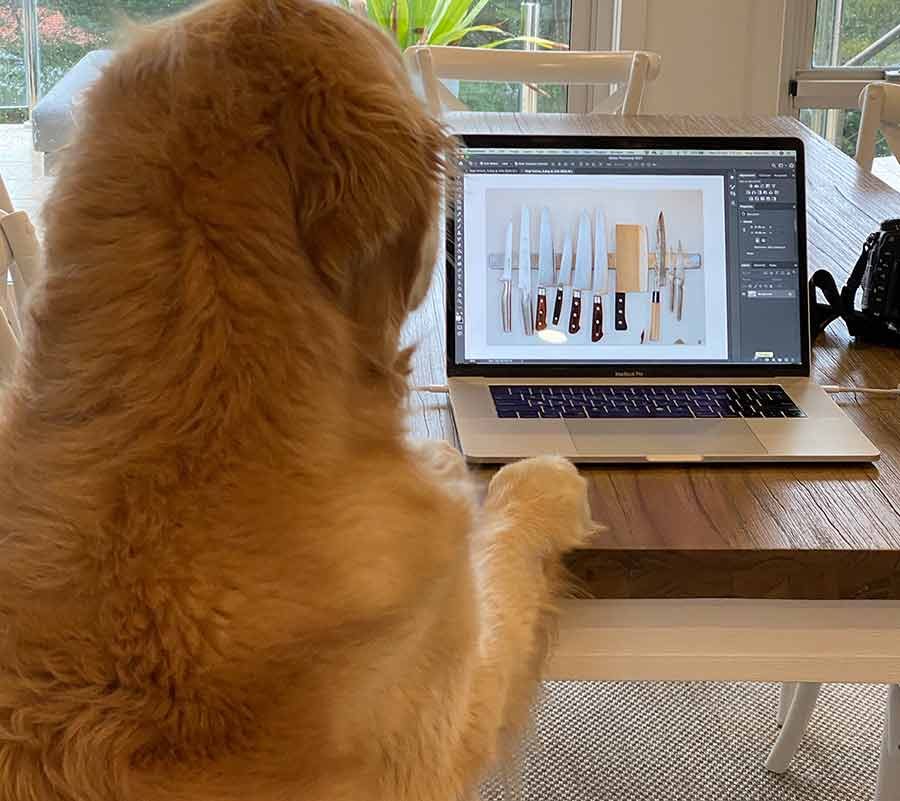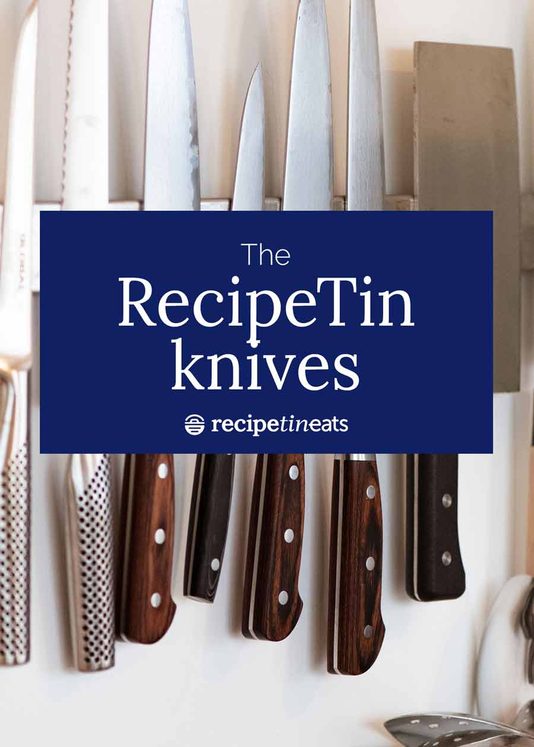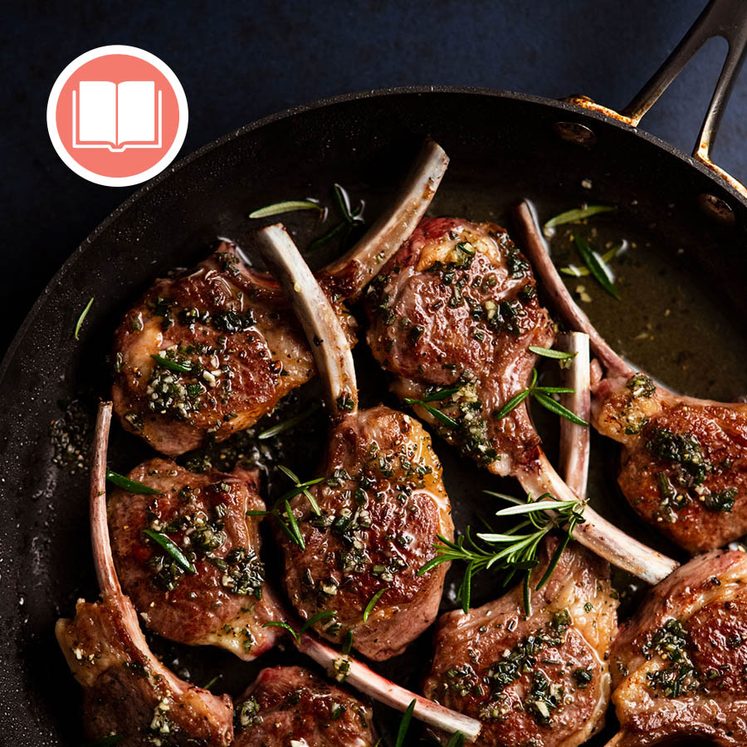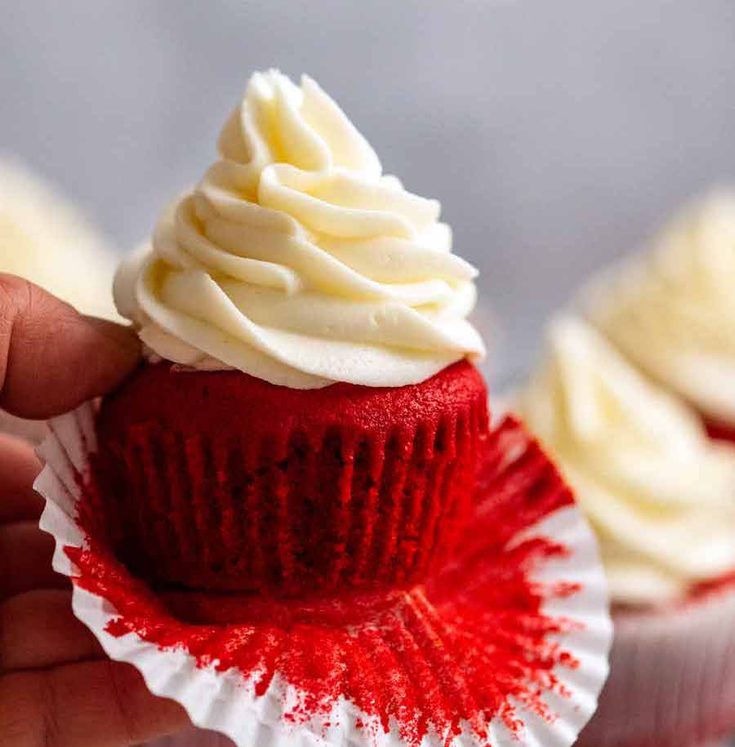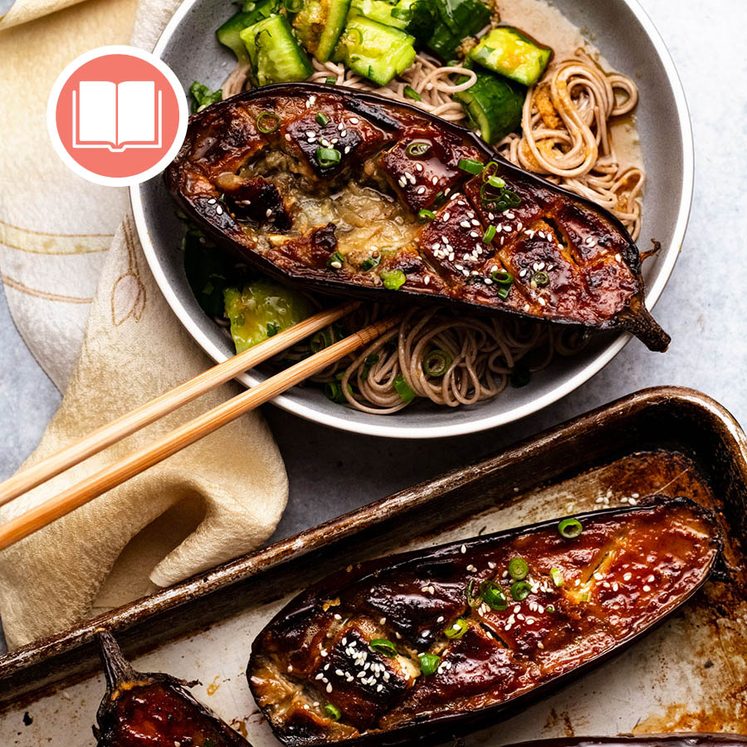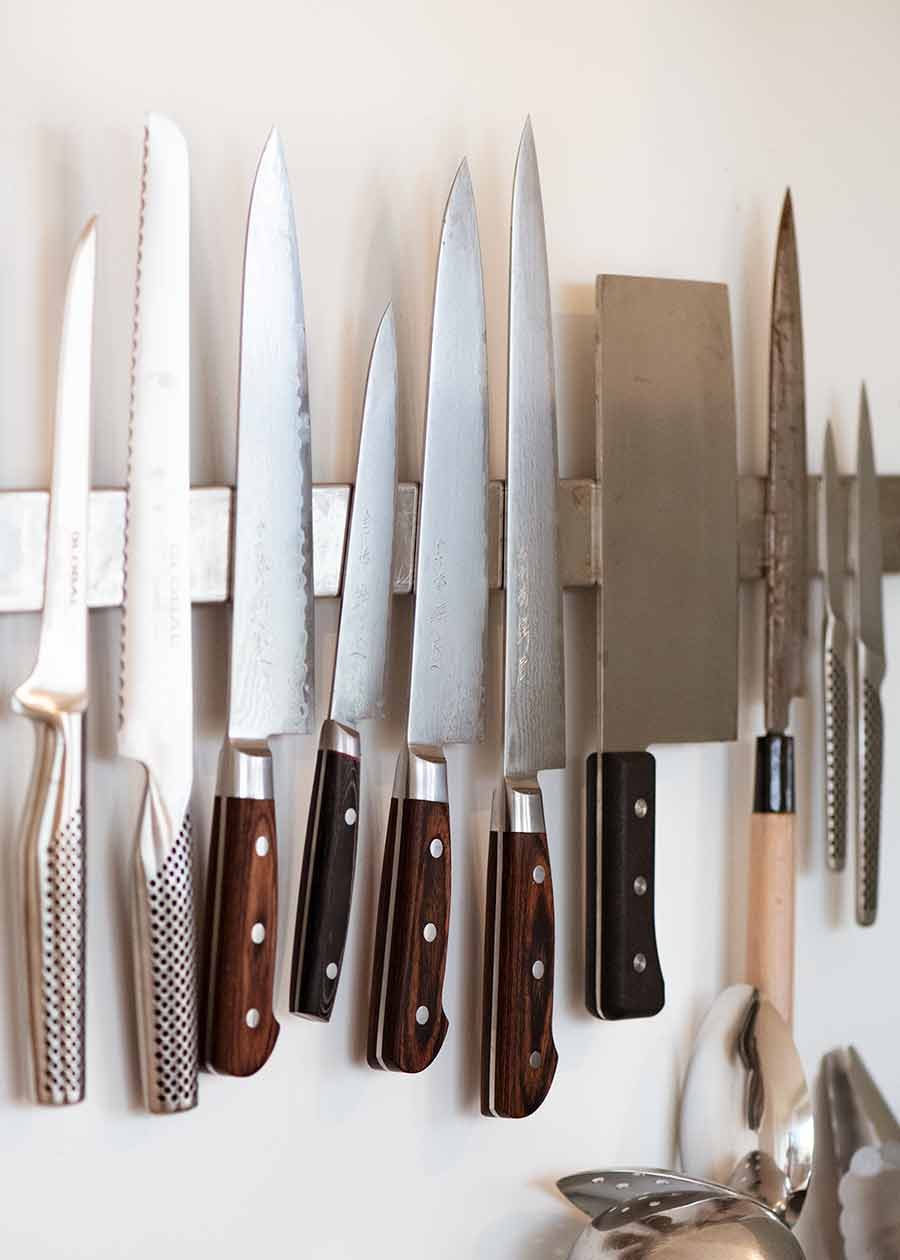
The difference between a sharp, high quality knife and a cheap, blunt knife is chopping speed, accuracy and keeping all your fingers. Yep, contradictory as it seems, a blunt knife is often the biggest perpetrator of kitchen cuts! (More on this later.)
In this post, I’m sharing details about the chef’s knife I can’t live without, as well as the other knives I own and what I use them for.
My knife collection
Here’s a photo of my personal knife collection. I do not have a replica of all of these in my studio kitchen – only my essential knives which I’m covering in this post!
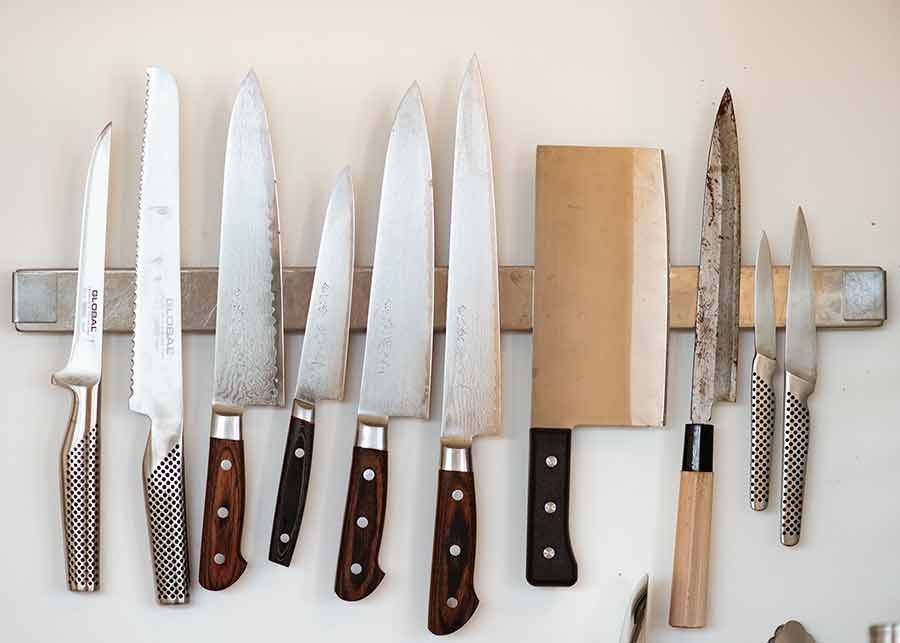
You don’t need all those knives I have above to get started with your knife collection. I have listed what I consider the most essential knives to own, and what I actually have. As you can see, the list is very short – one key knife, one bread knife, optional utilities knife!
Essential knives round-up!
Knife 1: Chef’s knife
-
My favourite: Japanese handcrafted SETO VG10 Gyuto 21cm/8.5″ blade with mahogany handle from Tsubaya, a knife shop in Tokyo, Japan (international deliveries available). Unfortunately the knife maker no longer makes this particular knife. However, the shop owner is very familiar with RecipeTin readers! So if you tell him the details of my knife above (by email or in person, if you visit) and mention my name, he will recommend the most similar one currently available. I’ve tried a couple of other similar ones and they are all just as good.
-
Second pick: Global 20cm / 8″ G-2 Cooks Knife plus a sharpener (everyday sharpener, pro version rod + whetsone).
-
Third pick: Wüsthof 8” Classic Chef’s Knife.
Knife 2: Bread knife
Global 22cm/9″ bread knife
Knife 3: Smaller knife (utility knife)
15cm Global Utility Knife
Or … Full knife set
Value option: Global Ikasu 7 Piece Knife Block Set
Knife 1: Chef’s knife
A chef’s knife is the workhorse knife of the kitchen. It is the blade you will use by far most frequently for chopping (and other things) due to its size and design. Since it’s the knife you’ll be using most, it’s truly worth investing in a good quality knife that is comfortable to use, stays sharp for longer and will serve you well for many years or even a lifetime.
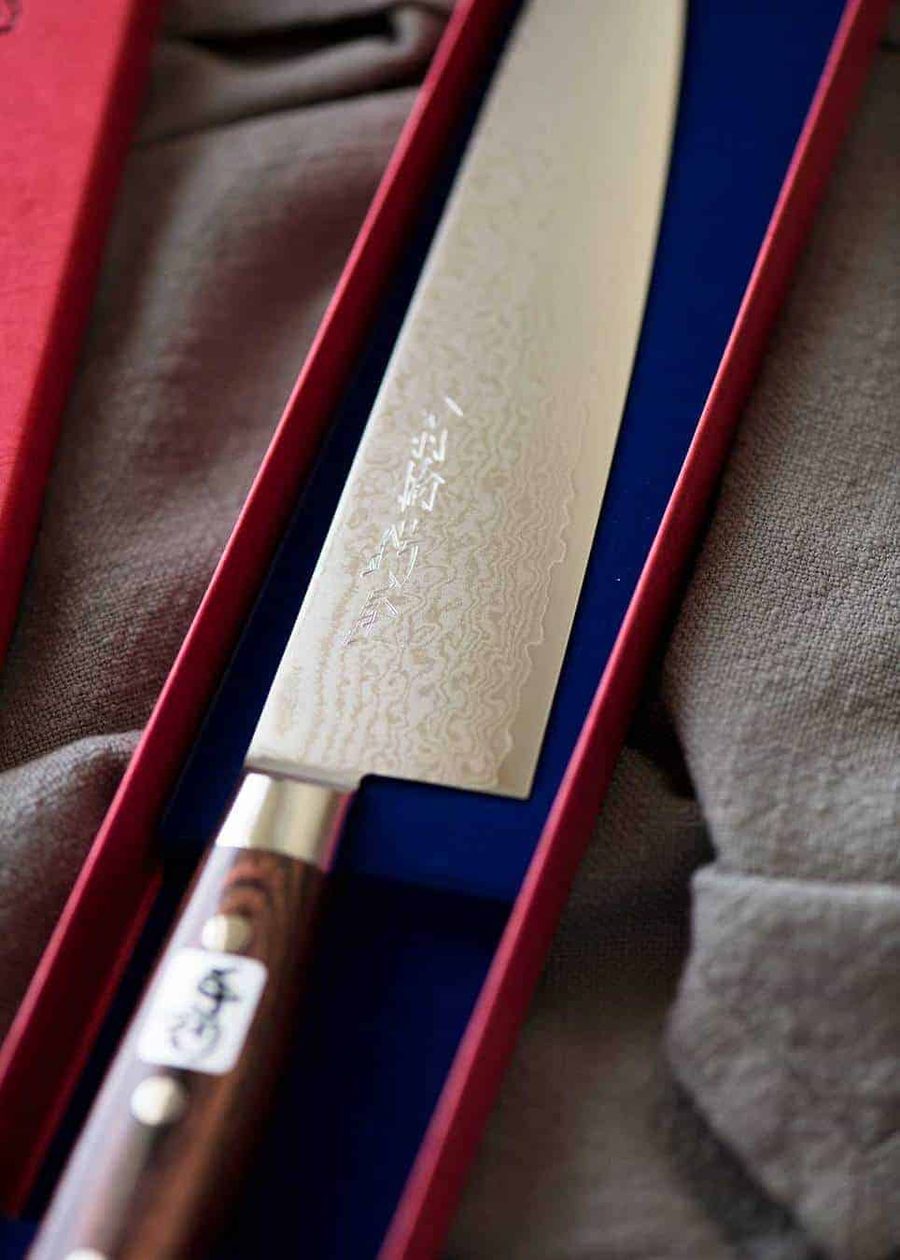
Having a good and sharp knife is also a safety thing. A knife that can’t cut easily can cause the food to slip away as you slice, and put your finger in it’s place. Blood … everywhere …
My favourite knife: Handcrafted Japanese chef’s knife
The single most valuable item in my kitchen is my handcrafted Japanese chef’s knife. It’s actually a Western-style knife (ie. specifically shaped for Western cookery), but handmade by Japanese artisans using forging techniques traceable to the ancient art of samurai sword-making.
-
Sold in in Tokyo, Japan
-
Knife Name: Handcrafted Japanese Chef’s Knife from Tsubaya knife shop in Tokyo, Japan – SETO VG10 Gyuto 21cm/8.5″ blade with mahogany handle. No longer available, but see point below about similar knife.
-
Blade length: 21cm / 8.5″
-
Store: Tsubya in Kappabashi, Tokyo https://tsubaya.co.jp
-
Price: ¥23,100 (~A$300)
-
Whetstone sharpener: Ask the shop for the recommended whetstone
GETTING A SIMILAR KNIFE FROM TSUBAYA
The knife maker no longer makes the exact knife I have. In fact, with all handcrafted Japanese knives there is limited availability because it just depends how long the knife maker makes a particular knife for.
If you would like a similar knife, when you visit Tsubaya knife shop in Tokyo (and it’s amazing how many RecipeTin readers have!) or you email them via their website, just mention my name, the knife I have (above) and ask for what they have which is similar.
The shop owner is very familiar with me and my family, and they have now served an amazing number of visitors that have come to the shop asking for the RecipeTin Knife. So he will know exactly what to recommend. In fact, he has sold me similar knifes to the SETO and I would happily make any of these my everyday Chef knife.
Blade length matters (mine is 21cm/8.5″), and if you are at the shop, the feel of the handle. Trust me, you will just “know” if you love the feel. If you are after a knife for a larger person, you might want to go up a little in size (as in, 1cm / 1/2″ or so). I have given my SETO knife to many men, including tall Chefs, and they all love it. So I promise it’s not too small, even for big men!
⚠️ Don’t forget a sharpener! Handcrafted Japanese knives are best sharpened using a whetstone. Ask the shop to recommend a whetstone for the knife you get, plus a non-slip base for the whetstone. Whetstones are also available in Australian stores, so don’t fret too much if you forget to get one.
My knife is an all-rounder with a 21cm/8.5″ blade and a wooden handle that I use for everything from mincing garlic to dicing vegetables, cutting meat and slicing cake. And yes, I have two of them!
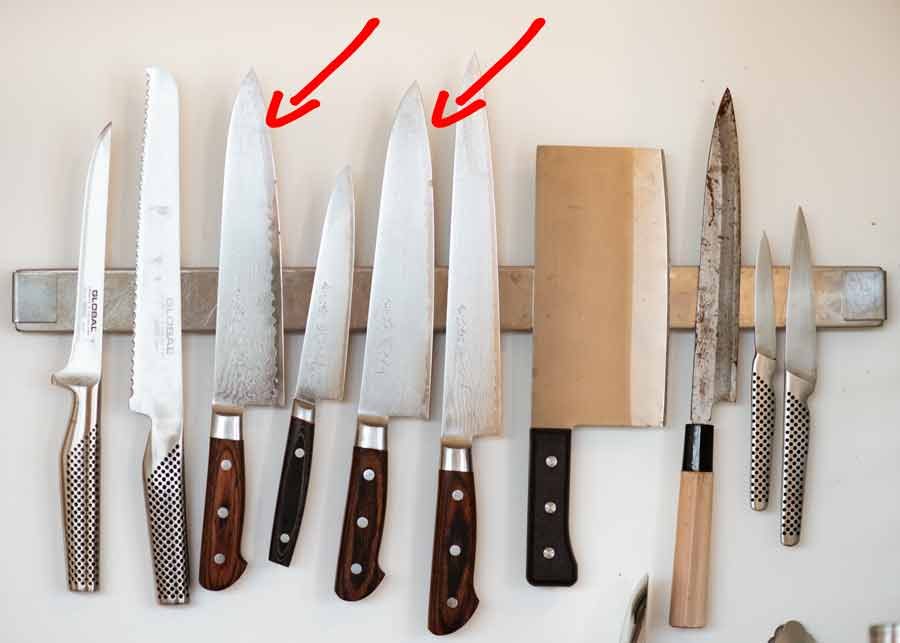
Why I prefer Japanese knives
I prefer Japanese handmade knives firstly because the metal is harder than European or cheaper knives, due to the way they are forged. This means it holds its edge better, staying sharper for longer.
The drawback however is it also means the knife is more brittle than European and other knives, which are made of softer steel. Trying to cut through a bone or something similarly hard with my knife will almost certainly chip the edge. This is the trade-off for a longer lasting edge. However, since I look after my knives and only chop boneless meat and vegetables etc with it, it’s not an issue.
I also like the knife’s weight, balance and the thinness of the blade, allowing me to make accurate cuts when dicing or slicing finely.
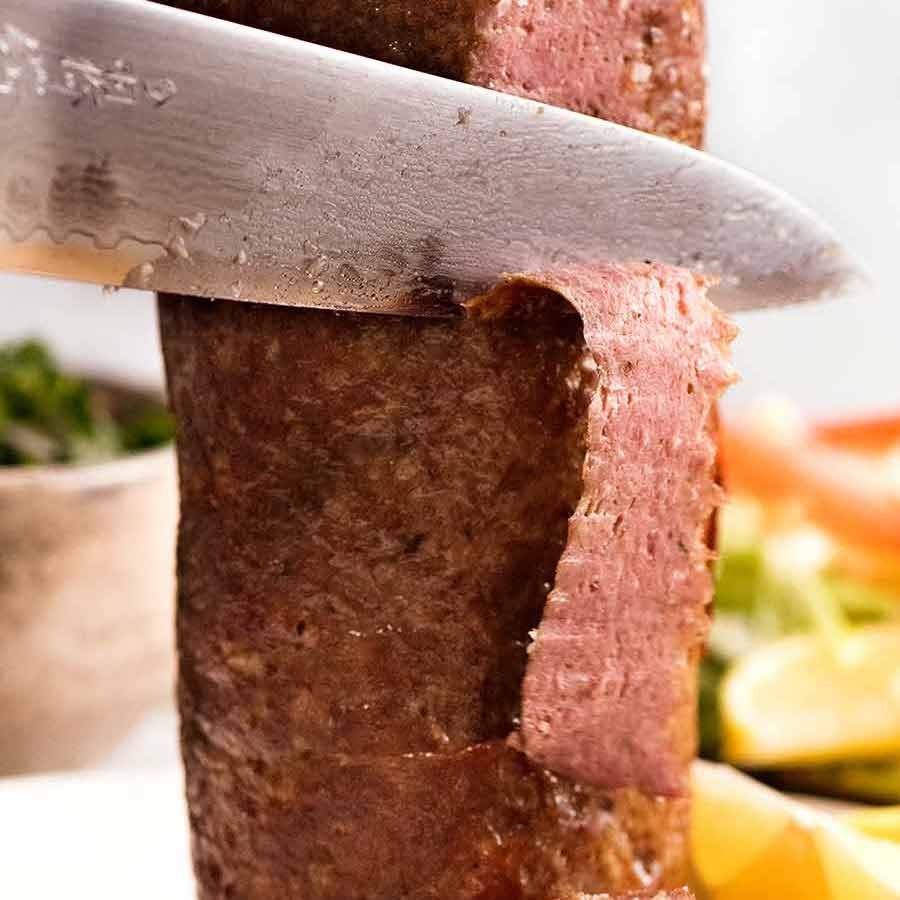
Finally, as you can see, handcrafted Japanese knives are are also incredibly beautiful with their rippled steel finish and gorgeously crafted wooden handles (though the looks are not the main reason I bought it!!).
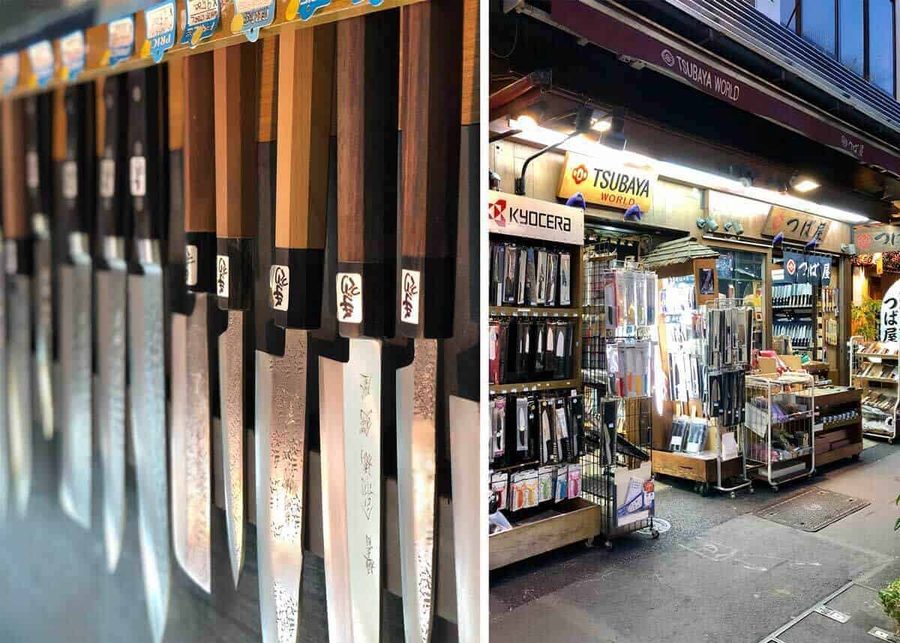
Where to get my Japanese knife
The exact knife I use was handmade by a Japanese knife maker and was only sold at a particular knife shop shop in Tokyo called Tsubaya. It is unfortunately no longer available, but see the box at the top of the post for getting a similar knife (I myself have gotten similar ones from this store, and I love them all).
I purchase all my personal knives from the store in Tokyo, in person, because I like to feel and choose my knives myself. However, Tsubaya does do online orders and they ship internationally, and I have purchased quite a few online for gifts and reader giveaways. Excellent service!
Any finely handcrafted knife requires intensive labour and skill, so naturally this knife is quite an investment. It clocks in at around AU $350 for the knife plus a Japanese-made whetstone (ie. a sharpening stone – essential for sharpening knives).
This knife maker of course is not the only one in Japan, and there’s even non-Japanese knife makers outside the country who use similar Japanese techniques to produce similar high quality knives.
However I would never try to recommend alternatives without actually having used them myself.
Japanese Knife store – Sydney (and online)
But for Sydney-siders, I can recommend Chef’s Armoury, the best Japanese knife store in Sydney, and they can provide you with excellent advice for choosing a knife. They also have an online store.
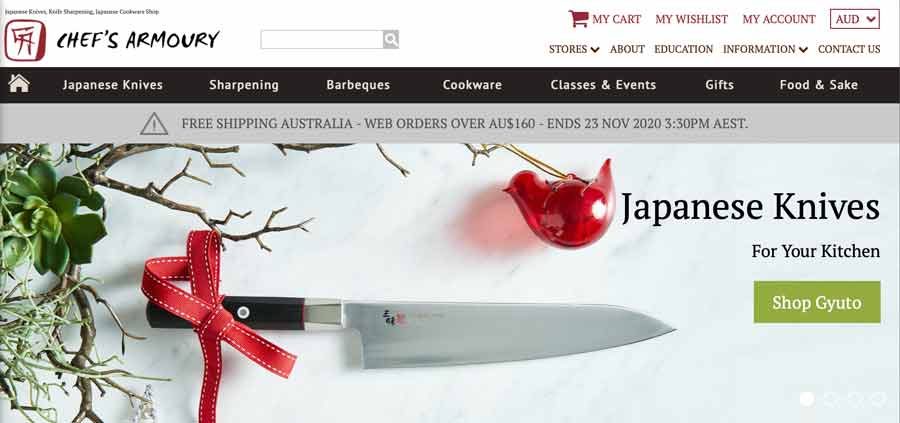
Second pick: Global G-2 Cooks Knife

A handcrafted Japanese chef’s knife is neither cheap nor easy to buy, so next is my top recommendation for a chef’s knife that’s much easier to find: The 20cm/8″ G-2 Cooks Knife. It’s also the knife I had been using all my adult life up until 6 years ago when I was gifted my first handcrafted Japanese knife.
Global Knives is a world-renowned Japanese knife brand, known for their precision-made, high quality knives sold at a reasonable price point.
The 20cm Cooks’ knife is their all-time best selling knife. It is very well-balanced, light and comfortable to hold, and I would have happily used it for the rest of my life had I been none the wiser.
Global knives’ steel is slightly softer than a handcrafted Japanese knife, which means the edge can take more punishment before it chips. However as explained earlier, softer steel also means it won’t hold its edge quite as long as a handcrafted Japanese knife.
This chef’s knife is listed on the Global Knives website with an RRP of $199 but a quick online hunt will uncover much better deals, eg. on Catch.com.au for $79, Australia’s Victoria’s Basement for $89 or Peters’ of Kensington for $104).
TIP: If you don’t own a knife sharpener, I’d recommend picking one up by getting the Global Cook’s Knife + sharpener set: Kitchen Warehouse $99, $115 at Victoria’s Basement or Peters of Kensington.
Third pick: Wüsthof 20cm Classic Chef’s Knife
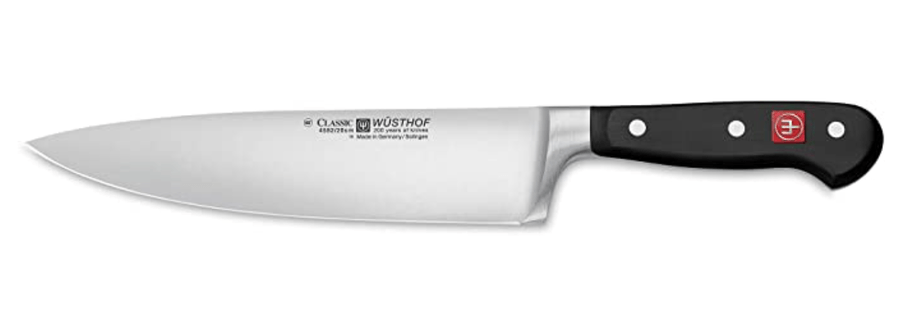
The German-made Wüsthof 8”/20cm Classic Chef’s Knife is very popular in the US. Wüsthof is an excellent brand, and this knife too is a great all-rounder – I know fellow food bloggers who use it.
German knives are heavier, more solid and typically have thicker blades. This makes them rugged and so are great if you’re after a lower maintenance knife that can take a beating.
However because of these qualities, I can’t use it quite as deftly and swiftly as Japanese knives which are known for being lighter. But it is still an excellent, highly-rated knife and I’d recommend it as the next best alternative that I personally have tried.
Knife 2: Bread knife

If a second knife is on the cards, make it a good bread knife because the one thing an all-rounder / chef’s knife cannot do well is cut bread without crushing it (especially true of soft rolls, brioche, hot dog buns etc). You need a serrated-edged knife for this job.
A bread knife is also useful for surprisingly more than just slicing bread:
-
They’re essential for levelly cutting off the tops of cake;
-
Are the best tool for carving pork roasts with crackling into neat slices with crackling intact, because you can saw through the crackling;
-
Cutting through a delicate short crust of a tart etc without crushing it;
-
Any job that could use a bit of a sawing action, like cutting through the chine bone joints when carving up a lamb rack
-
Neatly slicing things encased in puff or other pastry, eg. spanakopita, terrine en croute, Beef Wellington, pies.
A bread knife ain’t just a knife for bread!
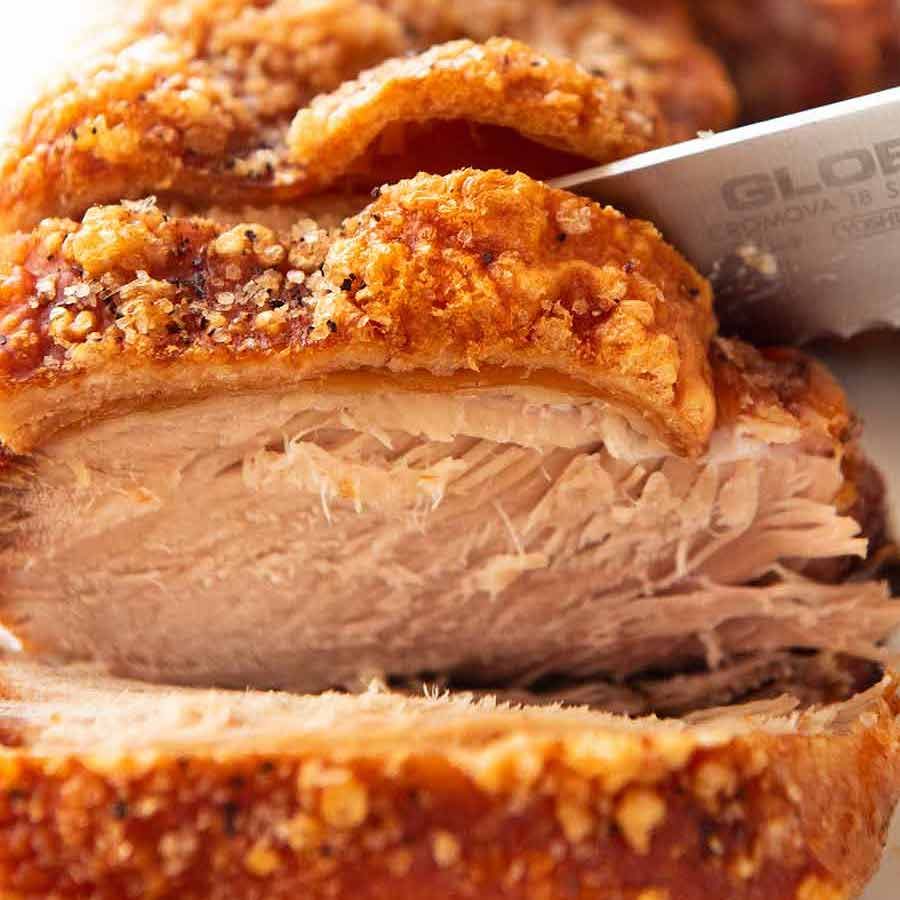
The Global 22cm / 9″ bread knife is the one I’ve had for 15 years and counting. I went Global again because it’s particularly important to get a quality bread knife in part because you can’t sharpen it (at least not by yourself or without special tools).
I went budget for my new studio kitchen bread knife and just 3 weeks in, I already regret it. Levelling cakes straight, cutting even slices of crusty baguettes for crostini – it was awkward and giving me all kinds of headaches! Massive regrets … I’ll just have to stump for another Global.
The Global 22cm / 9″ Bread Knife has a RRP of $179 on their site, but can be found for much better value: Australia – here, here and here.
Knife 3: Small knife (utility knife)
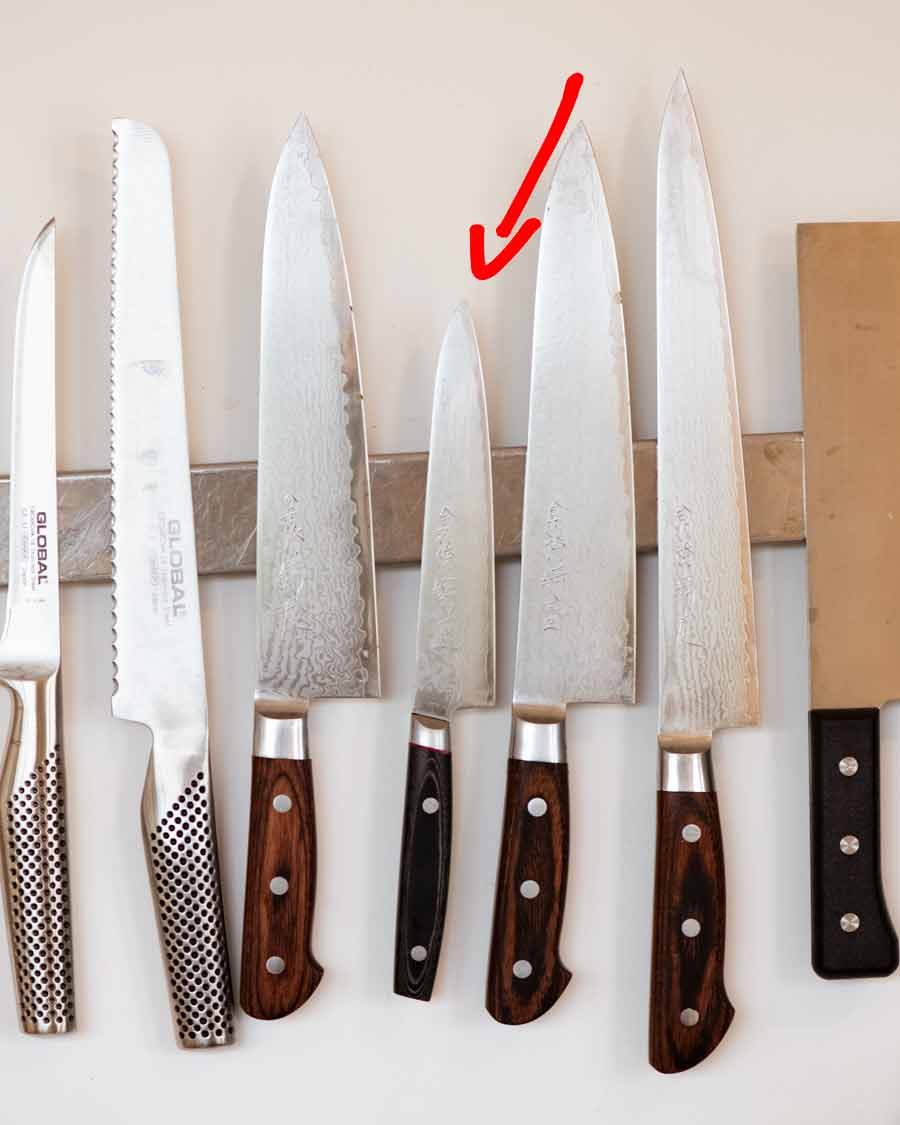
While you can tackle just about any chopping job in the kitchen between a chef’s knife and a bread knife, the fact is sometimes an additional smaller knife is undeniably handy.
Some things are just easier with a small knife: Coring or peeling an apple, deveining prawns/shrimp, or just when you need to pry something out with a small knife tip, for example. It’s also just incredibly handy to have a second knife around when your main chef’s knife is already in use or dirty.
What I would not recommend though is getting a paringknife. These knives have blades that are only around 8cm/3.5″. These knives are simply too small to be really useful in my experience for anything other than basic fruit cutting. And the only time I’ve picked one up is in desperation because every other knife I had was dirty!
Instead I’d recommend you get a knife with a longer blade around 11 – 15cm (4.7″ – 5.9″). These are often called utility knives and are more like a mini chef’s knife! You will find this far more versatile, believe me.
Again, I prefer a handcrafted Japanese knife if possible for such a knife. Otherwise, I go Global like this 15cm Global Utility Knife. You can pick one up from Everten for $83, Catch.com.au for $89 or Victoria’s basement for $69.
Other knives I have

-
Fish filleting knife (16cm blade) – New to the collection as I hone my skills filleting a whole fish! I have this Global Classic 16cm boning knife (GF 31). It is non-flexible. I find you have far better control with a non-flexible knife. Save flexible knives for boning out meat, if that’s your thing;
-
Meat knife (24cm blade) – a long bladed knife especially for cutting into large blocks of meat. This too is a Japanese knife from the same Tokyo knife shop listed above. I can’t find one online that I confidently know to be the same but will come back later and update the post if I do;
-
Chinese butcher knife – A very heavyweight knife for hacking through bones like you see in Chinese butcher shops, like for Chinese roast duck and Hainanese chicken. I got mine from an Asian grocery store for around $20 – most have a kitchenware section;
-
Sashimi knife – For slicing raw fish, the shape of the blade is intended such that you can cut the fish in one long clean stroke without the knife wandering, for a very clean cut. The one I have is the first Japanese knife I ever bought for for myself and it was quite cheap but does the job ok. Here is a similar Global one; and
-
Paring knives x 2 – as mentioned above, I rarely use these. Maybe to slice strawberries, if the utility knife is otherwise dirty! I mostly use them to cut into steaks etc for recipe videos – because they do cut more cleanly than eats knives. I only have these because I got them as part of a full knife set – next section!
Alternative: A full knife set
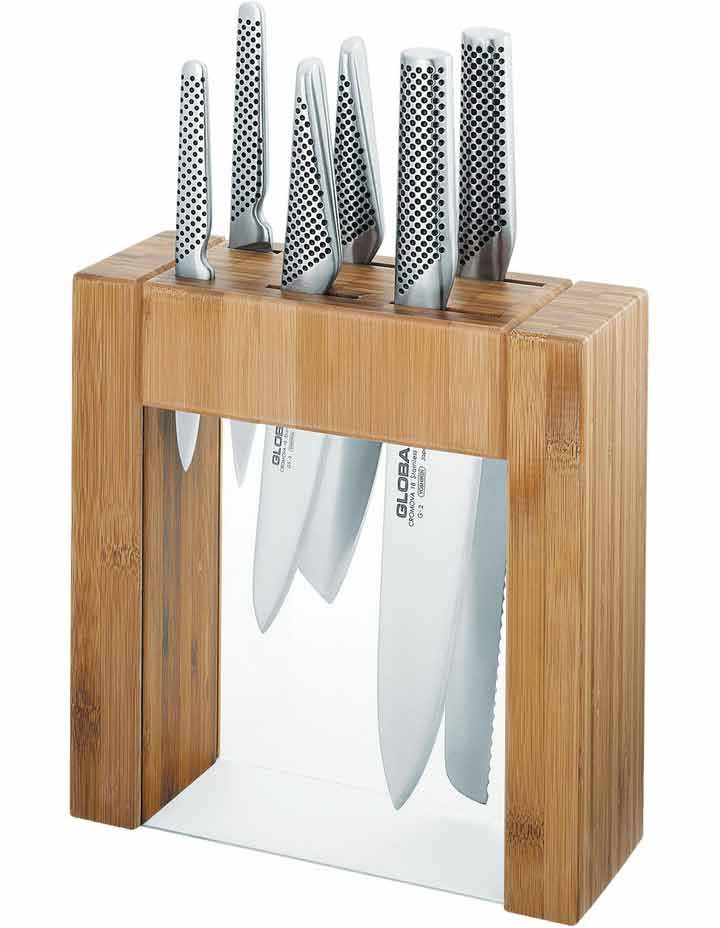
Bulk buying knives in a set is always better value for money than buying the knives individually.
This Global Ikasu 7 Piece Knife Block Set is what I was given as a “get out of my house!” gift from my mother when I left home at the tender age of 18.
It includes the two essentials I list above – chef’s knife, bread knife – as well as number of smaller knives of varying blade shapes and grips that I still use to this day. The 2 smallest knives are the 2 paring knives you see on my knife rack!
The set also comes with a well-designed Global knife block that has a very small footprint and glass sides so you can see which knife is which (smart!).
Don’t let the hefty RRP price tag of $899 scare you – the knife sets can always be found at steep discounts, $299 here and here (US: Amazon).
Sharpening knives
Keeping a knife sharp not only a pleasure to use and makes lighter work of chopping and slicing, but is also important for safety. A blunt knife is more likely to cut you, because the food can slide away as you try to cut through it, causing you to cut yourself.
I’m going admit something: I hate sharpening knives. I find it tedious and time-consuming – which is why I usually convince my brother or mother to sharpen my knives!
While there are plenty of knife sharpening gadgets out there, none will produce that true razor edge like a whetstone can. While learning to use a whetstone takes practice, it is not not as difficult as it looks. This video tutorial gives a great introduction to whetstone sharpening technique.
I use a whetstone bought from the same shop as my handmade Japanese knives, which has two grits (1000 and 3000). I find this is all you need.
Finally, there are knife sharpening services you can pay for. However, nearly all use a motorised grinder for efficiency. While they will give you a sharp edge, they also will inevitably take off much more metal than sharpening by hand, shortening the life span of your knife.
And that, my friends, is my knife collection!
Woah. That is a lot of info about a knives. But the volume of writing does represent how important my knives are to me. I’ve always said that in the event of an emergency, the first thing I’d grab is Dozer, the 2nd thing my handbag, and the third thing? My Chef’s knife!!!
Hope you found this useful! – Nagi x
Life of Dozer
Very interested in today’s post because he knows these knives cut up tasty meats for him….
